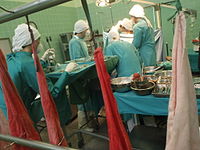
Photo from wikipedia
OBJECTIVES Donor-derived malignancy of the liver allograft is a rare but serious condition in the setting of necessary immunosuppression. Retransplantation after abrupt immunosuppression cessation has been performed with durable cancer-free… Click to show full abstract
OBJECTIVES Donor-derived malignancy of the liver allograft is a rare but serious condition in the setting of necessary immunosuppression. Retransplantation after abrupt immunosuppression cessation has been performed with durable cancer-free survival. METHODS We present 2 cases of patients with donor-derived malignancy who were treated with complete immunosuppression cessation, which induced rapidly progressive liver allograft rejection and failure, with a need for subsequent retransplantation. We reviewed all serial liver biopsies and explants from both patients and performed C4d immunostaining. RESULTS Initial explants of both patients showed severe allograft rejection, with unusual features of sinusoidal obstruction syndrome and C4d positivity. Malignant tumors in the explants were necrotic, related to rejection of donor-derived cancer cells and tissue. Follow-up of both patients has shown long-term cancer-free survival but issues with recurrent allograft failure requiring a third transplant. The reasons for retransplantation in both cases were related to allograft failure from antibody-mediated rejection. CONCLUSIONS Clinicians should be aware of a potentially increased risk of rejection and recurrent allograft failure when strategizing treatment of donor-derived malignancy with immunosuppression cessation and retransplantation.
Journal Title: American journal of clinical pathology
Year Published: 2022
Link to full text (if available)
Share on Social Media: Sign Up to like & get
recommendations!